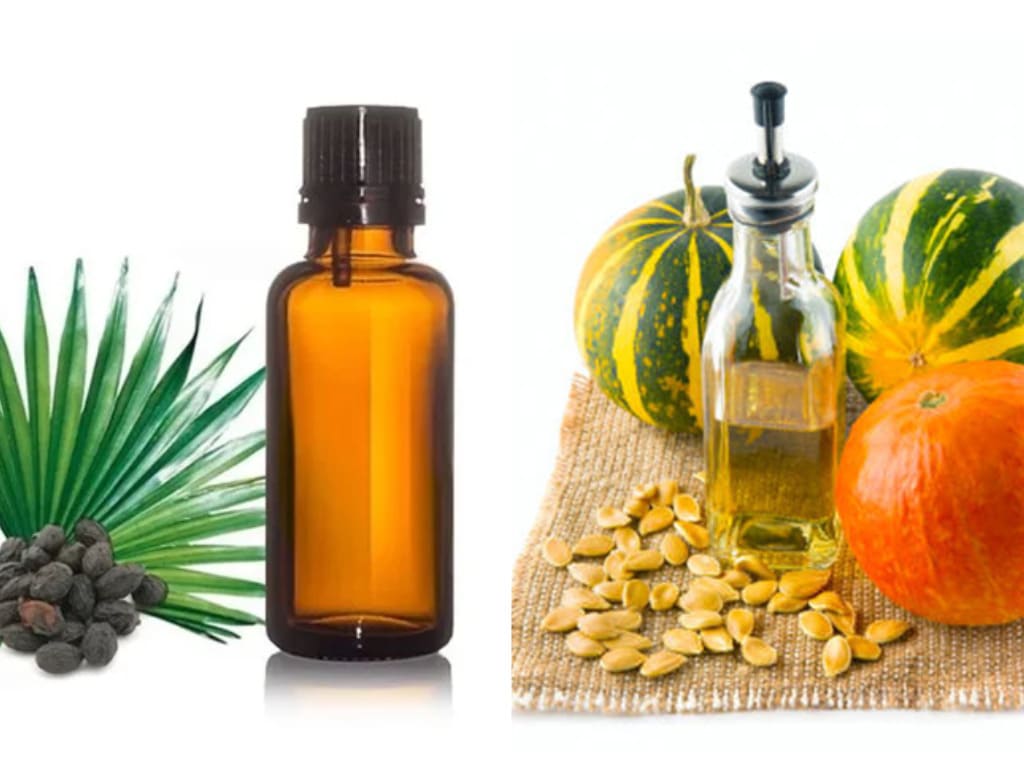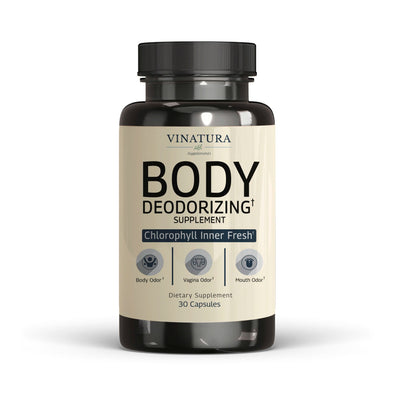
Saw Palmetto Vs Pumpkin Seed Oil: Can You Combine Them?
Combining Saw Palmetto vs Pumpkin seed oil is gaining interest among those seeking alternative support for hair loss and prostate health. Both are known to influence DHT levels—one of the primary drivers of androgen-related hair thinning—through slightly different mechanisms. While each shows promise on its own, early research and anecdotal reports suggest that using them together may enhance results. This article explores their similarities, differences, and whether taking them in combination is both safe and beneficial.
Before exploring further, please read the disclaimer located at the end of this webpage.
Key Takeaways
- Saw palmetto and pumpkin seed oil have been studied for their potential influence on pathways related to hair biology, including 5α-reductase activity.
- Both oils are safe with no side effects when used alone, but consult a doctor before combining.
- No studies confirm the effects of combining them for hair loss, whether taken orally or applied; more research is needed.
About Saw Palmetto
Saw palmetto, derived from the berries of the Serenoa repens plant, is a popular herbal remedy known for its potential to support prostate health and hair loss. It works by inhibiting 5α-reductase, an enzyme that converts testosterone to DHT, a key factor in androgenetic alopecia (AGA) in men. [2,3]
About Pumpkin Seed Oil
Pumpkin Seed Oil, a treasure derived from pumpkin seeds, is extracted from fertile regions such as Central Europe, Eastern Europe, and Asia.
Packed with omega-6 fatty acids, vitamin E, and antioxidant carotenoids, this oil offers remarkable benefits: it nurtures a healthy heart, supports optimal thyroid function, and promotes smooth skin and shiny hair. [1]
Read more: Saw Palmetto vs. Finasteride: Hair Loss in Men and Women
Saw Palmetto vs. Pumpkin Seed Oil: How Do They Help with Hair Loss?
|
Saw palmetto oil |
Pumpkin seed oil |
|
|
Main mechanism |
Inhibits 5α-reductase, the enzyme that converts testosterone to DHT (which causes hair loss) [6,8,9] |
Inhibits 5α-reductase, may block androgen receptors, reducing DHT-related hair loss [8,9] |
|
Both have been studied for their potential to influence DHT-related pathways, which are involved in hair follicle biology. |
||
|
Specific studies |
In a study of 47 men using a lotion twice daily for 12 weeks, the average hair count significantly increased from 49.8 at baseline to 55.9 after 12 weeks [4]. |
A 24-week study reported a 40% increase in hair count among men using 400mg of pumpkin seed oil daily, compared to 10% in the placebo group [8,9]. Topical use in women with FPHL was associated with reduced fine hair and increased density after 3 months [9]. |
|
Effectiveness |
Topical use in men has shown potential effectiveness in small studies and was generally well tolerated [3]. |
Oral use in men and topical use in women have shown preliminary benefits in small studies. |
|
Limitations |
Needs larger, longer-term studies; no data for women. |
Limited studies on FPHL with small sample sizes and short durations. |
Saw palmetto and pumpkin seed oil are gaining popularity for their potential to naturally support hair growth and scalp health. On platforms like Reddit, however, users share mixed experiences with products that combine these ingredients.
For example, user gaby_ramos reported less hair fall and signs of new growth after 3–4 months of consistent use, while another user, crashlandingonwho, saw no noticeable results.
These contrasting results highlight an important point: what works for one person may not work for another. Differences in body chemistry, the underlying cause of hair loss, or even how the product is used can all affect outcomes.
Beyond the pumpkin seed oil and saw palmetto duo, some formulas also include DIM (Diindolylmethane) and spearmint—especially in products marketed toward women. These ingredients are often chosen for their ability to support hormonal balance, which plays a key role in hair and skin health.
DIM helps regulate estrogen by promoting beneficial metabolites [11], while spearmint may help reduce testosterone levels [12]. Saw palmetto, on the other hand, is thought to block DHT.
This functional synergy reflects feedback from users on platforms like Amazon. For instance, user Pureafinacho shared that a supplement containing saw palmetto, DIM, and spearmint helped reduce unwanted hair growth and improve skin clarity.*
Overall, saw palmetto oil and pumpkin seed oil have attracted attention for their potential to safely address hormone-related hair loss. While both target DHT, they differ in how they work and how people respond—raising the common question: can they be used together effectively?
Saw Palmetto vs. Pumpkin Seed Oil: What’s the Difference Between Them?
To better understand the similarities and differences in how saw palmetto oil and pumpkin seed oil support hair growth, the table below provides a detailed comparison of their mechanisms of action.
|
Criteria |
Saw Palmetto Oil (Serenoa repens) |
Pumpkin Seed Oil (Cucurbita pepo L.) |
|
Source and Composition |
Extracted from saw palmetto berries using solvents or supercritical CO₂ [2]. Contains beta-sitosterol (59.4%) and fatty acids like oleic (49.1%) and lauric (17.6%) [1]. Does not contain vitamin E [2]. |
Extracted from pumpkin seeds. Rich in unsaturated fatty acids, mainly linoleic (64%) and oleic, plus phytosterols, carotene, and minerals [6]. |
|
Health Benefits |
|
|
|
Side Effects |
When used topically for hair loss, no side effects were reported in a 12-week study. Safe and well-tolerated [4]. |
Oral capsules show no side effects compared to the drug tamsulosin [8]. |
|
Availability and Price |
Often found in cosmetics and dietary supplements. Limited information on price and availability [6]. |
More widely available, found in capsules or as a topical hair oil. Easily found in pharmacies and cosmetic markets [8]. |
In summary, saw palmetto oil is commonly used in topical formulations that support hair and scalp health in men, particularly in cases of androgen-related hair concerns.
Pumpkin seed oil (PSO) offers more versatility, as it is used both orally and topically and contains compounds such as delta-7-sterols and linoleic acid, which have been studied for their roles in supporting prostate and hair wellness in both men and women.
While PSO is often highlighted for its broad range of applications, saw palmetto is also considered safe and well-tolerated.
So, could combining the two deliver even better results?
Can You Combine Saw Palmetto and Pumpkin Seed Oil?

Saw palmetto and pumpkin seed oil can be safely mixed. Both reduce a hormone (DHT) that causes hair loss and prostate issues by blocking an enzyme [2,3].
In a study, men with prostate problems took 320 mg of pumpkin seed oil daily along with saw palmetto. After three months, participants noted changes in urinary patterns, though prostate size and PSA levels remained unchanged. These findings were associated with improvements in urinary comfort [1].
However, no significant changes were observed in prostate volume or prostate-specific antigen (PSA) levels during the study [2].
For hair loss, no study has checked how they work together [1]. On their own, saw palmetto lotion helps men with hair loss [5]. Pumpkin seed oil supports hair growth in men and women [6,7]. Their similar action hints they could work well together [2,4]. More studies are needed to confirm their potential benefits for hair loss [2].
On Reddit, user feedback on combining pumpkin seed oil and saw palmetto is quite mixed, but most report no noticeable improvement even after using both consistently for 4–6 months. Some point out that research on this combination is still limited.*
Additionally, it's important not to rely too heavily on personal testimonials found online, as everyone’s body and the causes of hair loss can differ. If you're experiencing hair loss, it's best to get a blood test to check for vitamin and mineral deficiencies before starting any supplement.*
Learn more: Saw Palmetto vs Maca: Which is Better for PCOS in Women?
How to Take Saw Palmetto and Pumpkin Seed Oil Together

A 2009 study by Hong et al. involved 47 Korean men with BPH symptoms, divided into four groups: placebo, saw palmetto, pumpkin seed oil, and a combination of both. The combination group took 320 mg/day of each, in two capsules daily—one in the morning and one in the evening, after meals [10].
While this study focused on prostate health, it offers insight into safe dosing when combining the two oils. Today, many hair loss supplements use similar combinations, though dosage and timing can vary based on the specific product.
If using a topical serum, it's usually applied once or twice daily to the scalp. As always, follow the product instructions or consult a doctor.
Supporting this, one user reported that after 3–4 months of taking a supplement with both ingredients, her ponytail felt noticeably thicker, and she experienced minimal shedding while brushing.*
Learn more: 5 Best Saw Palmetto Supplements for Hormone Balance
What to Know When Combining Saw Palmetto and Pumpkin Seed Oil
The first thing you should do is consult a doctor, because using each ingredient individually is quite common and has shown positive effects.
However, combining them hasn’t been studied extensively. You could end up in one of two situations: either you take them and notice no real effect, or you take them and experience an allergic reaction. So, proceed with caution.
That said, a study by Hong et al. in 2009 did find that combining saw palmetto and pumpkin seed oil significantly was associated with self-reported improvements in urinary comfort in studies focused on men with benign prostatic concerns, compared to using either oil alone [10].
However, it’s important to note that this study focused on prostate health, not hair loss—and overall, there's still not enough evidence to confirm they work well together for other conditions like androgenetic alopecia.
If you're unsure, it’s always best to talk to a healthcare professional or consider starting with just one ingredient.
Conclusion
Saw palmetto and pumpkin seed oil can be combined, especially when taken orally. While they are not intended to reverse hair loss, they show potential to help reduce it. However, research is limited, and clear evidence on the combination’s effectiveness for hair loss in men and women is lacking. Used separately, both support hormonal hair loss (AGA in men, FPHL in women). More studies are needed to confirm the benefits of combining them.
Testimonial Disclaimer
*The testimonials presented on this website are provided by individuals based on their personal experiences with our products. These testimonials represent individual opinions and experiences, which may not be typical or applicable to all users of our products. Results may vary depending on a variety of factors, including individual health, lifestyle, and adherence to product usage instructions.References
- [1] George, M., Das, P., Soji S, & S, A. C. (2015). WJPR - Abstract. World Journal of Pharmaceutical Research. https://wjpr.net/public/index.php/abstract_show/1358
- [2] Ham, Bryan, et al. “A Study of the Physical and Chemical Properties of Saw Palmetto Berry Extract.” papers.ssrn.com/sol3/papers.cfm?abstract_id=2969217. Ssrn.com, Feb. 2002, Accessed 7 May 2025.
- [3] Promise Ufomadu. “Complementary and Alternative Supplements: A Review of Dermatologic Effectiveness for Androgenetic Alopecia.” Baylor University Medical Center Proceedings, vol. 37, no. 1, 29 Sept. 2023, pp. 111–117, https://doi.org/10.1080/08998280.2023.2263829.
- [4] AUNG, Phyo Zaw. “EFFICACY and SAFETY of TOPICAL PURE SAW PALMETTO (SERENOA REPENS) EXTRACT LOTION in ANDROGENETIC ALOPECIA.” Procedia of Multidisciplinary Research, vol. 2, no. 10, 2024, pp. 3–3, so09.tci-thaijo.org/index.php/PMR/article/view/5277. Accessed 7 May 2025.
- [5] Cho, Young Hye, et al. “Effect of Pumpkin Seed Oil on Hair Growth in Men with Androgenetic Alopecia: A Randomized, Double-Blind, Placebo-Controlled Trial.” Evidence-Based Complementary and Alternative Medicine: ECAM, vol. 2014, 2014, p. 549721, pubmed.ncbi.nlm.nih.gov/24864154/, https://doi.org/10.1155/2014/549721.
- [6] Emre, Gizem & Koçyiğit, Mine & Haspolat, Yusuf. (2025). Medicinal Seeds and Some Important Ingredients.
- [7] Shaban, Ahmed, and Ravi P. Sahu. “Pumpkin Seed Oil: An Alternative Medicine.” International Journal of Pharmacognosy and Phytochemical Research, vol. 9, no. 2, 15 Feb. 2017, https://doi.org/10.25258/phyto.v9i2.8066.
- [8] Zerafatjou, Nikan, et al. “Pumpkin Seed Oil (Cucurbita Pepo) versus Tamsulosin for Benign Prostatic Hyperplasia Symptom Relief: A Single-Blind Randomized Clinical Trial.” BMC Urology, vol. 21, no. 1, 19 Oct. 2021, https://doi.org/10.1186/s12894-021-00910-8.
- [9] Ibrahim, Ibrahim M., et al. “Pumpkin Seed Oil vs. Minoxidil 5% Topical Foam for the Treatment of Female Pattern Hair Loss: A Randomized Comparative Trial.” Journal of Cosmetic Dermatology, vol. 20, no. 9, 12 Feb. 2021, pp. 2867–2873, https://doi.org/10.1111/jocd.13976.
- [10] Hong, Heeok, et al. “Effects of Pumpkin Seed Oil and Saw Palmetto Oil in Korean Men with Symptomatic Benign Prostatic Hyperplasia.” Nutrition Research and Practice, vol. 3, no. 4, 2009, pp. 323–327, www.ncbi.nlm.nih.gov/pmc/articles/PMC2809240/, https://doi.org/10.4162/nrp.2009.3.4.323. Accessed 24 Mar. 2020.
- [11] Kim, S. (2016). Cellular and Molecular Mechanisms of 3,3′-Diindolylmethane in Gastrointestinal Cancer. International Journal of Molecular Sciences, 17(7), 1155–1155. https://doi.org/10.3390/ijms17071155
- [12] Mahmood Sadeghi Ataabadi, Sanaz Alaee, Bagheri, M. J., & Soghra Bahmanpoor. (2017). Role of Essential Oil of Mentha Spicata (Spearmint) in Addressing Reverse Hormonal and Folliculogenesis Disturbances in a Polycystic Ovarian Syndrome in a Rat Model. Advanced Pharmaceutical Bulletin, 7(4), 651–654. https://doi.org/10.15171/apb.2017.078
Author

Product Disclaimer
Including an ingredient or study does not evaluate, endorse, or recommend any Vinatura product or any third-party product. Some ingredients discussed may not be used in any Vinatura product.
The content of the articles has not been evaluated by the Food and Drug Administration (FDA) and is not intended to promote or endorse any specific product. Any products sold on this website are not intended to diagnose, treat, cure, or prevent any disease.
Opinions and Endorsements
Any claims, statements, or opinions expressed in the articles are those of the author(s) and do not necessarily reflect the views or opinions of the manufacturers of the dietary supplement products. The products sold on this website are separate from the content of the articles and are not directly endorsed or associated with the information presented here.
Liability Disclaimer
The author(s) of the articles, website, and manufacturers of the dietary supplement products do not assume any liability for any potential consequences arising from the use of the information provided in the articles. Ingredient effects, dosages, and safety vary by individual, formulation, and context; some ingredients interact with medications or may be unsuitable during pregnancy or lactation. It is recommended that individuals consult with a qualified healthcare professional before making any dietary or lifestyle changes, including the use of dietary supplements.
Product Usage
Please refer to the product labels and packaging for specific usage instructions and guidelines for the dietary supplement products sold on this website.
Customer Support
For any concerns or questions regarding the dietary supplement products, please contact our customer support team, who will be more than happy to assist you.





Leave a Comment
Be the first to comment.
What do you think?